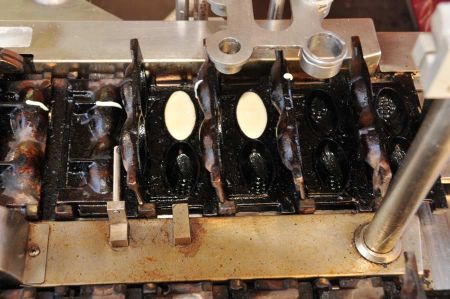Wunderwaffelmaschine at Festival in Augsburg
- Written by Portal Editor
After the successful musical conclusion of Sunday by the local band "Backdoor Connection", who had already travelled to Turkey several times for concerts, we set out on our last tour of the festival grounds for the day.
And, as on the other days, there was something extraordinary to discover and test, which we would like to inform you about: today the wonder waffle machine.
 Together with Lydia and Georg, singer, guitarist and bandleader of Backdoor Connection, we had started the evening tour when we got hungry. All kinds of delicacies are extensively provided at the Grenzenlos, so that you can always keep an eye out for special delicacies. So we came across a small, inconspicuous stand that offered just such small but fine waffles. A waffle isn't really anything special at first, because there are a wide variety of shapes and combinations of these age-old pastries, which were topped with a icing of liquid chocolate at this stand.
Together with Lydia and Georg, singer, guitarist and bandleader of Backdoor Connection, we had started the evening tour when we got hungry. All kinds of delicacies are extensively provided at the Grenzenlos, so that you can always keep an eye out for special delicacies. So we came across a small, inconspicuous stand that offered just such small but fine waffles. A waffle isn't really anything special at first, because there are a wide variety of shapes and combinations of these age-old pastries, which were topped with a icing of liquid chocolate at this stand.
Plum-sized waffles with a chocolate coating
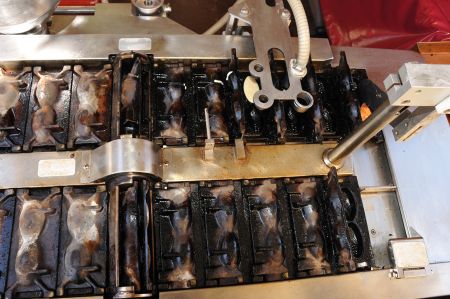 Each of us is certainly familiar with the wide variety of waffle irons from our own household. For some, the thick, heart-shaped waffles served with fruit or cream are really delicious, for others it's the "New Year's waffles", which are mainly known in the north, and whose batter is baked so thin with aniseed and then is rolled, which crumbles when it is firmly grasped. Here at the Grenzenlos there were small waffles, about the size of plums, with a chocolate coating. But in the end it wasn't the waffles that fascinated us, although really delicious, no, it was the device used to make the waffles.
Each of us is certainly familiar with the wide variety of waffle irons from our own household. For some, the thick, heart-shaped waffles served with fruit or cream are really delicious, for others it's the "New Year's waffles", which are mainly known in the north, and whose batter is baked so thin with aniseed and then is rolled, which crumbles when it is firmly grasped. Here at the Grenzenlos there were small waffles, about the size of plums, with a chocolate coating. But in the end it wasn't the waffles that fascinated us, although really delicious, no, it was the device used to make the waffles.
To date, the origin and first use of waffle irons have not really been researched. In the 12th and 13th centuries they were known in France under the term "gaufrier", around 1300 in the Netherlands, and from the 14th century they can be found throughout Western and Central Europe. Preliminary forms have been discovered in Sweden and Norway, where round-topped baking irons have been found in women's burials from the Viking Age in the seventh to tenth centuries, which were not yet decorated. In the 9th century, a waffle iron "oblatorium" is mentioned in Normandy, which may have been used to bake communion wafers.
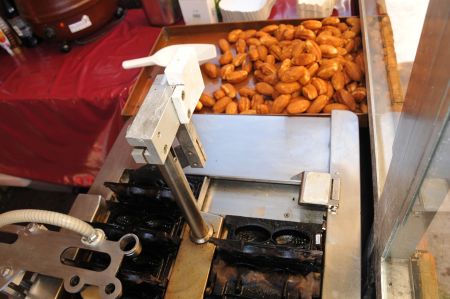 Waffle irons usually consist of two iron plates. The outside is smooth, the inside has a structured honeycomb or triangular pattern, an inscription or a picture as a negative template for the future waffle shape. Two irons are always required, a lower part and a matching upper part. As a rule, both parts are connected to each other like pliers with a hinge and equipped with two rods as a handle. When baking over an open fire, long handles were required to keep a sufficient distance from the fire. Waffle irons have been richly engraved since the second half of the 13th century. Even if the same topic was dealt with in several irons, there were only a few cases where the type of presentation corresponded. In most cases, the designers of the irons remained anonymous, with names or initials being the exception. Since the 15th century, the originally only round plates have also been made in rectangular shapes in France.
Waffle irons usually consist of two iron plates. The outside is smooth, the inside has a structured honeycomb or triangular pattern, an inscription or a picture as a negative template for the future waffle shape. Two irons are always required, a lower part and a matching upper part. As a rule, both parts are connected to each other like pliers with a hinge and equipped with two rods as a handle. When baking over an open fire, long handles were required to keep a sufficient distance from the fire. Waffle irons have been richly engraved since the second half of the 13th century. Even if the same topic was dealt with in several irons, there were only a few cases where the type of presentation corresponded. In most cases, the designers of the irons remained anonymous, with names or initials being the exception. Since the 15th century, the originally only round plates have also been made in rectangular shapes in France.
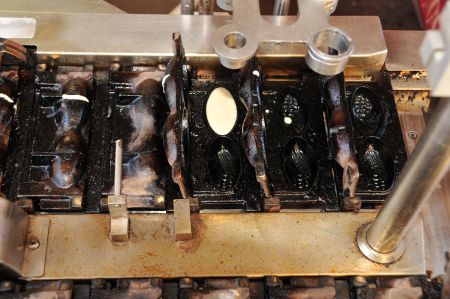 Forged irons have been decorated using three main techniques since at least the 15th century, according to the observation of waffle expert Thiele:
Forged irons have been decorated using three main techniques since at least the 15th century, according to the observation of waffle expert Thiele:
- Chisel technique: the cross or flat chisel was held with the left fist and struck with a hand hammer. This crude technique could be developed into quite perfect designs.
- Engraving technique: Here the work was carried out solely by hand pressure, without a hammer. The lines of the graphic were carved freely from the iron plate. Areas were usually filled in with dashed lines or punches, blow next to blow.
- Working with shape stamps: Recurring details of the pictorial representation and ornamentation were embossed with shape stamps (crosses, circles, animal figures).
Many irons, according to Thiele, were created without prior templates, others testified to a well-planned overall design. In the case of round iron, there is often a hammered-in centre on which the further composition of the picture is based, a central picture as decoration and an inscription or ornament surrounding the edge. Rectangular irons provide space for inscriptions or sequences of images arranged from left to right.
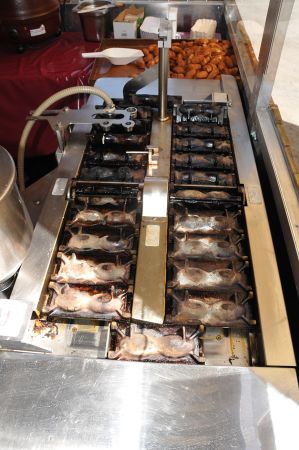 The company "Schnitzler und Kirschbaum (tools and small hardware)" in Solingen offered forged, engraved waffle irons in 1830: "Rectangular plates with wide square waffles; Heart-shaped platters with diamond-shaped waffle; Round plates with a narrow square waffle and a border ornament of semicircles and triangles”. In the 1930s, Ernst Thiele encountered blacksmiths in Fläming and East Friesland who at least occasionally made hand−forged waffle irons.
The company "Schnitzler und Kirschbaum (tools and small hardware)" in Solingen offered forged, engraved waffle irons in 1830: "Rectangular plates with wide square waffles; Heart-shaped platters with diamond-shaped waffle; Round plates with a narrow square waffle and a border ornament of semicircles and triangles”. In the 1930s, Ernst Thiele encountered blacksmiths in Fläming and East Friesland who at least occasionally made hand−forged waffle irons.
But now quickly back to our miracle waffle machine on the festival site, which is heated electrically today and whose Molds also consist of iron parts, but many waffle Mold parts that are pushed over a heating plate, which also has an automatic turning device and automatic dough filling and emptying the baking process, all of this combined on an area of 1.20 meters by 40 centimetres. Our interest was aroused immediately, so we asked the master of the wonder waffle machine for more information. And Benny, as the "baker" is called, was also ready to explain the process.
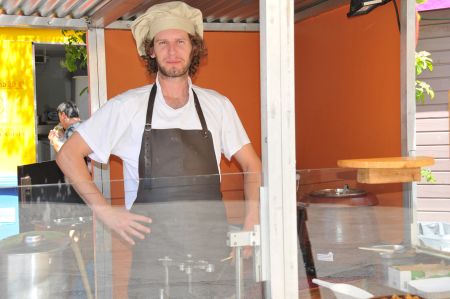 After the dough has been made (understandably the recipe is not passed on), the almost liquid mass is filled into a storage container. A quantity of dough corresponding to the shape is pumped into the waffle blank via a pump hose. Then the waffle maker closes automatically by attaching a counterpart as a lid. Up to four waffle Molds can be filled at the same time, depending on how the waffles are sold. Now a motor pushes the filled waffle iron a little forward, waffle irons that have just been emptied get under the filling device. The baking heat comes continuously from below to all Molds, so that there is always baking temperature. Around the middle of the baking system, four irons are turned at the same time and then the heating plate is placed back. This way, both sides are baked evenly. At the end of the baking line, the Molds are also automatically emptied into a large storage container.
After the dough has been made (understandably the recipe is not passed on), the almost liquid mass is filled into a storage container. A quantity of dough corresponding to the shape is pumped into the waffle blank via a pump hose. Then the waffle maker closes automatically by attaching a counterpart as a lid. Up to four waffle Molds can be filled at the same time, depending on how the waffles are sold. Now a motor pushes the filled waffle iron a little forward, waffle irons that have just been emptied get under the filling device. The baking heat comes continuously from below to all Molds, so that there is always baking temperature. Around the middle of the baking system, four irons are turned at the same time and then the heating plate is placed back. This way, both sides are baked evenly. At the end of the baking line, the Molds are also automatically emptied into a large storage container.
If asked, Benny takes eight or twelve of these fine delicacies into a bowl and pours hot chocolate over them. It doesn't just look delicious. And now we enjoy our chocolate-covered waffles from the Wunderwaffel machine in peace and quiet in our caravan, of course we filter the coffee ourselves.
Please read as well:
